|
Stitching rate study by Stroboscopy of
a sewing machine
Andrew Davidhazy
Imaging and Photo Technology School of Photo Arts and Sciences Rochester Institute of Technology One of the laboratories that students in my High Speed photography course complete deals with the determination and photographic recording of the stitching rate of a sewing machine based on the use of stroboscopes. While the determination of the stitching rate can be made in real time using a stroboscope this lab experience requires that they provide substantiating and publishable photographic corroboration of the performance of the sewing machine driven by two different voltages resulting in two different stitching rates. The premise is that words alone are not necessarily reliable sources of information about the performance of a device. Photographic visualization of an event and associated data reduction methods substantiate words when communication about device performance is published. With this in mind, students are introduced to the basics of use and application of stroboscopes to study high speed repetitive events in real time and their application as tools to stop the action of repetitive events by the adjustment of the flashing rate of the stroboscope to synchronize with the action rate of the subject. In the case of a rotating fan, for example, by matching the flashing rate of the stroboscope to the rotation rate of the fan the fan is made to appear to be standing still, especially if ambient light is reduced. The fan (or other similar subject such as looms, printing presses, etc.) can then be made to appear to be performing its action slowly backwards or forwards in time by the simple expedient of making the stroboscope flash faster of slower than the repetition rate of the subject. This makes stroboscopes particularly useful for the study of high speed events as long as they are repetitive in their action. Such as sewing machines. In this experience students determine the stitching rate using two different kinds of stroboscopes. One is the conventional, flashing light, stroboscope and the other is a simpler, easily improvised, mechanical stroboscope that is within the means of just about any student to make. 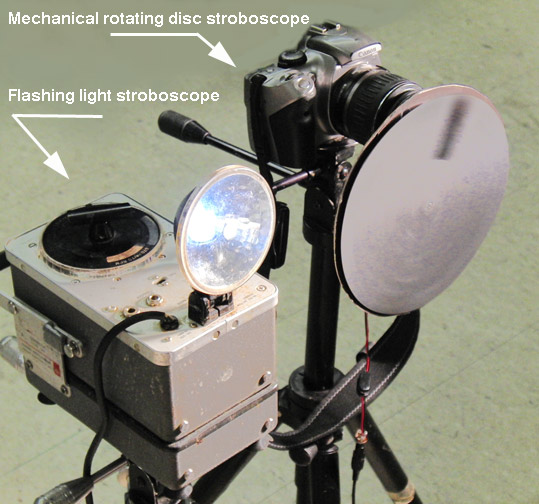 Since
the stroboscope is a flashing light source (or an interrupted one in
the case of the rotating disk stroboscope) there are periods of
darkness between flashes of light. This introduces a certain
level of uncertainty in the determination of stitching rate since if
the position of the needle is synchronized with the flashing rate of
the stroboscope the machine will look like it is stationary while in
fact it may have completed more than one or more cycles between flashes
of light. To remove this uncertainty and not lose sight of the location
of the needle a small tungsten light bulb is attached to the needle
mechanism of the machine. Since
the stroboscope is a flashing light source (or an interrupted one in
the case of the rotating disk stroboscope) there are periods of
darkness between flashes of light. This introduces a certain
level of uncertainty in the determination of stitching rate since if
the position of the needle is synchronized with the flashing rate of
the stroboscope the machine will look like it is stationary while in
fact it may have completed more than one or more cycles between flashes
of light. To remove this uncertainty and not lose sight of the location
of the needle a small tungsten light bulb is attached to the needle
mechanism of the machine. 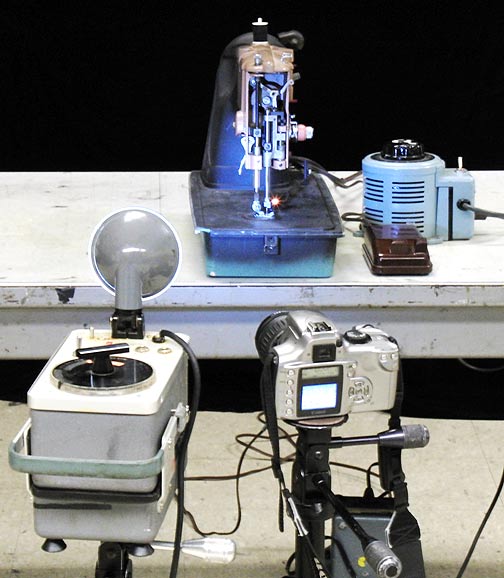 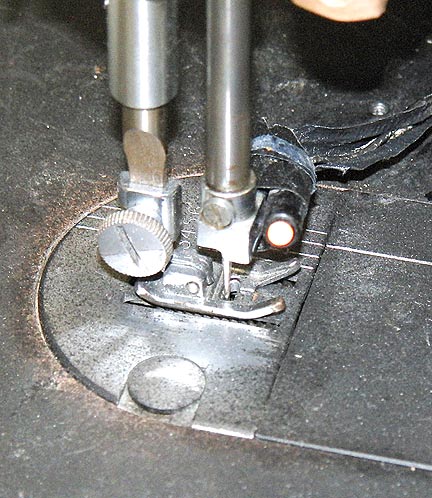 In order to record the action of the sewing machine and display it over time the camera is first aimed in such a manner that the machine is outside the field of the camera on one side. Once the camera shutter, set to a brief time, maybe 1 or 2 seconds is opened the camera is swung or rotated in such a manner that the image of the sewing machine in action is swept across the finder and off the field of view on the other side. The flashing rate of the stroboscope and the rotation rate of the camera determine the separation between consecutive images recorded on a given frame. 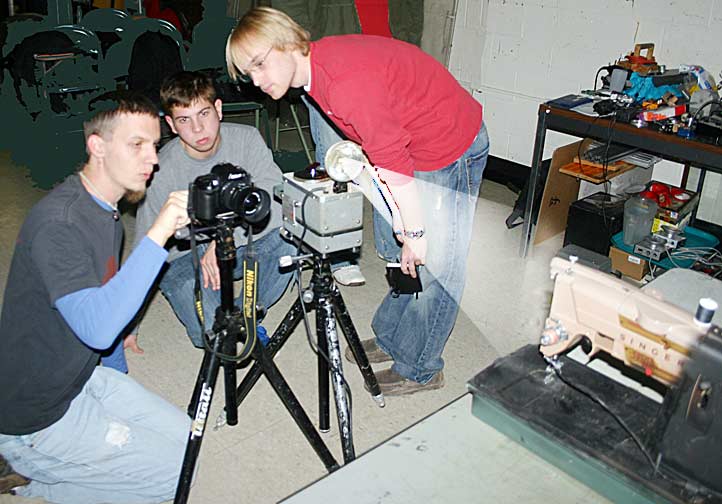 On
strictly photographic matters the sensor speed (ISO) and the lens
aperture are selected to provide a useable final image. These will
depend on the amount of light generated by the stroboscope. Placing a
large dark cloth or black paper behind the sewing machine will help
eliminate distracting elements from the background. On
strictly photographic matters the sensor speed (ISO) and the lens
aperture are selected to provide a useable final image. These will
depend on the amount of light generated by the stroboscope. Placing a
large dark cloth or black paper behind the sewing machine will help
eliminate distracting elements from the background.The results from the photographs recorded in this manner are shown below. The stroboscope was conveniently set to flash 10 times per second and so the time between images is 1/10 second. From a data reduction point of view one can either choose to make time a convenient factor or whole number of cycles. In the first instance, on the left, the sewing machine was supplied with 95 volts and it can be seen that in 4/10ths of a second the machine completed 2.7 (estimated) stitches. On the right, the number of stitches or cycles was chose to be the “convenient” factor. One starts on the left given a particular position of the needle and goes as far to the right as needed until the needle is in a similar position as in the first instance. The number of time intervals then is counted off and recorded. It can be seen that the machine completed 5 cycles in 3/10 seconds. 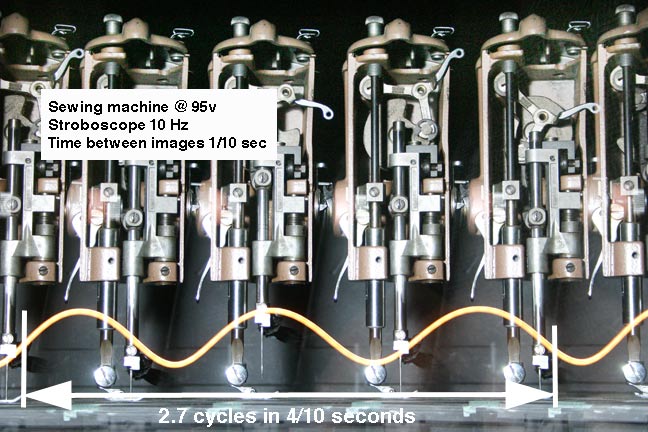 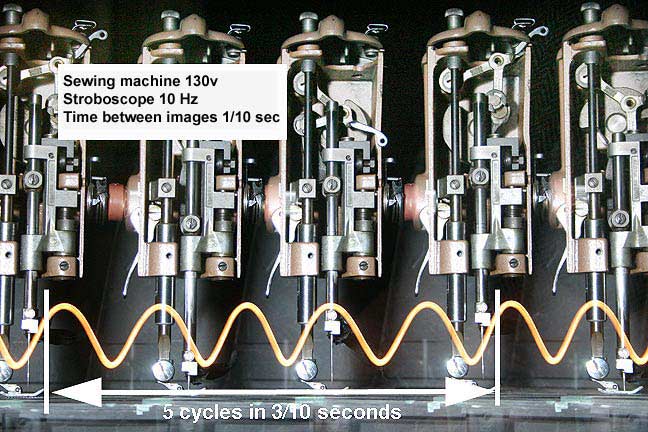 From the data gathered by these two photographs one can substantively state that the machine was stitching at a rate of 2.7 stitches in 4/10 seconds or 6.75 stitches per second and in the second instance it completed 5 stitches in 3/10 seconds or it was stitching at 16.6 stitches per second. In the first case at about ½ the flashing rate of the stroboscope and in the second almost at twice the flashing rate of the stroboscope. As shown below. the situation is somewhat different if a rotating disc, mechanical, stroboscope is used. While the overall impression of the movement of the machine is similar to that obtained with the flashing light kind of stroboscope unfortunately the light from the tungsten bulb disappear from view leaving us with no information as to what happened between individually recorded images. Ss with the light stroboscope the camera is also rotated so that the image of the sewing machine in operation sweeps across the camera’s sensor. A dark mask with an opening is used along with a dark background behind the machine to limit the amount of distracting elements superimposing themselves on the machine’s image. 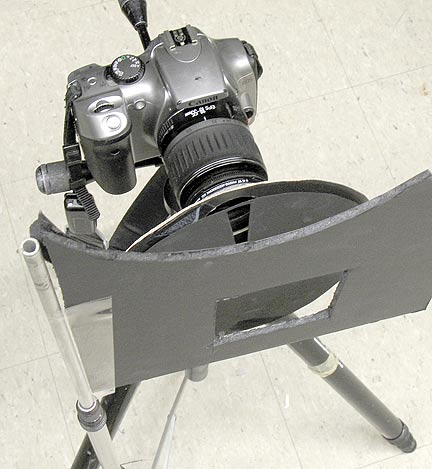 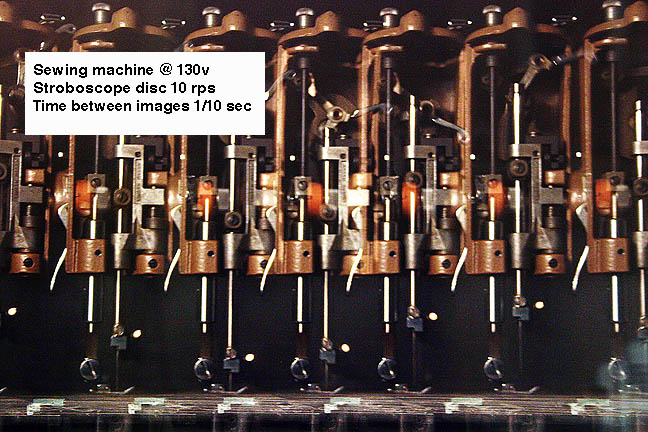 But here we are faced with the problem of not knowing whether the machine completed one, two or more stitches between rotations of the stroboscope disk. As the drawing below shows one can draw several lines of needle machine position but because the tungsten lamp is not recorded as a continuous trace we do not have a reliable method for determining the actual stitching rate of the sewing machine. This is the kind of record that we would have obtained with the flashing light kind of stroboscope had we not added the tungsten lamp to the needle mechanism. 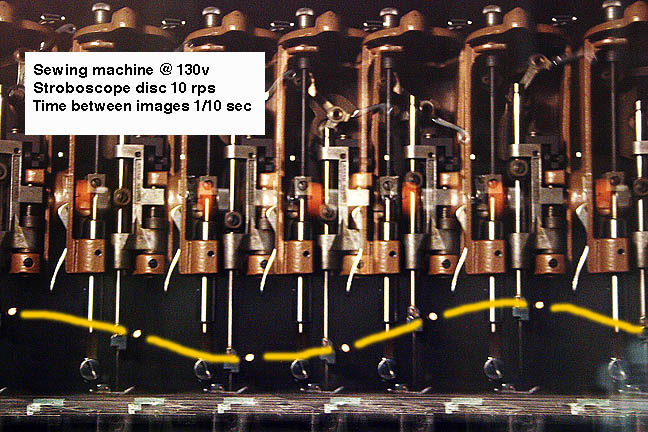 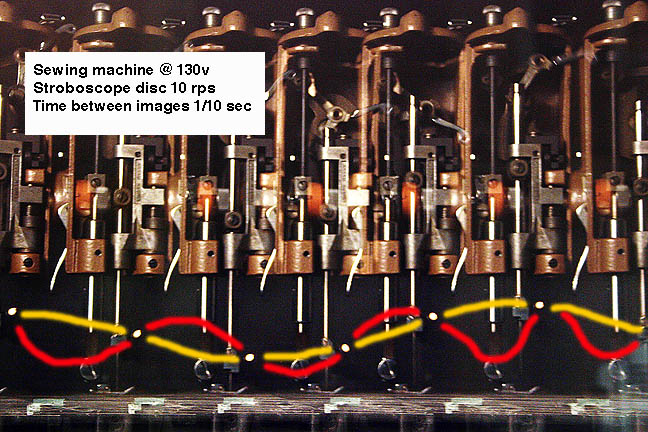 In this exercise the students learn to appreciate the “power” of the continuously recorded image of the tungsten lamp! On the other hand, data analysis can be performed using assumed data and leaving it to the students to draw in a logical continuous line of needle position over time as was done above. The situation with the rotating disk stroboscope is analogous to that we would face with any recording technique that looses sight of the moving subject for a period of time. This is the case with high speed motion picture cameras, video cameras, etc. The inclusion of the tungsten lamp makes the system behave like a “streak” system in the subject is being recoded all the time and no matter where it moves it’s position will be tracked and included along with any intermittent image that is also recorded. Food for thought: How might one be able to modify the rotating disk, mechanical, stroboscope so that an image of the tungsten bulb would be recorded along with the individual intermittent exposures of the sewing machine? If you have a creative solution to this question send it to me and I will add it to this article. Also, if you want to discuss this article feel free to write to me. Andrew Davidhazy, andpph@rit.edu |